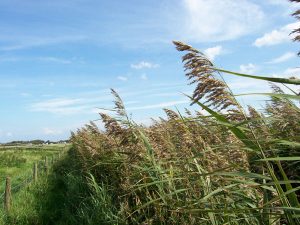Adsorption: attractive forces acting between particles in the wastewater draw them together, allowing them to settle to the base of the reed bed or wetland. Adsorptive forces also adhere pollutant particles to plant material and gravel or soil, trapping them within the system.
Bacterial action: wetland plants have adapted to grow in saturated conditions. One such adaptation is the ability to draw oxygen from the leaves to the roots. Oxygen is available in sufficient quantities for aerobic bacteria to thrive around the root zone. Bacteria also adhere to the gravel and root surfaces, cleaning the effluent passing through the system. In soil based constructed wetlands, the leaf litter provides this filter medium, to which the bacteria cling as they party on the rich pickings. All of these groups of bacteria feed on pollutants in the wastewater, playing a major part in the water cleansing process. The resulting microbial biomass (living and dead cells and microorganisms) settles out in the wetland and accumulates over time as soil on the base of the system.
BOD: biochemical oxygen demand – the amount of dissolved oxygen needed by aerobic biological organisms to break down organic material present in a the water.
Decomposition: different organic pollutants in the wastewater undergo reduction and oxidation (redox) reactions. This chemical process involves the transfer of oxygen, hydrogen and electrons within the wastewater, thereby lowering the pollution concentrations.
Dosing box: zero energy input system that stores water or effluent in a chamber or box up to a critical tipping point, at which the mechanism kicks in and delivers the stored effluent rapidly across the vertical flow reed bed surface.
Filtration: gravel and root growth act as physical filters in gravel reed beds, removing pollutants from the wastewater. In soil based constructed wetlands, the plant stems and leaf litter provide this filter layer, replenished naturally each year as the summer growth dies back in the autumn and falls into the water of the wetland marsh.
Head losses: falls in height as the effluent passes through a given system.
Gravity dosing mechanism: this may include a tipping bucket or syphon system to deliver effleunt in a pulse and thus ensure a good spread of effluent across the vertical flow reed bed surface, or may be a splitter system such as the Ribbit splitter (www.ribbit.ie) to give an even distribution from a number of pipe outlets.
Gravity splitter: a splitter system such as the Ribbit splitter (www.ribbit.ie) to give an even distribution from a number of pipe outlets.
Mechanical treatment unit: standard electric-powered packaged unit for effluent treatment.
Mechanical aeration unit: standard electric-powered packaged unit for effluent treatment.
Modular reed bed units: sometimes sold as a follow up system to provide tertiary treatment after a mechanical aeration unit. The reed beds arrive as precast plastic units which are then filled with pea gravel and planted with reeds. They are quite small, so rely on consistent high quality effluent treatment by the mechanical unit.
Nutrient uptake: plants growing in the system use nutrients in the wastewater for growth. The lush growth is due to this abundance of nutrient availability. Some of this will be released into the water again when the plants decay at the end of the growing season, but some is laid down as a peat layer within constructed wetlands, or can be harvested at the end of the season from reed beds for composting if desired.
p.e: population equivalent. In Ireland the EPA guidelines allow for 150 litres/p/d and 0.06kg/d of BOD loading. This is easy to imagine for a domestic dwelling of 5 people, because you’ll have 5 p.e. But for a town with several industries, the population may be 10,000, but the effluent loading may be 20,000pe after addition of the BOD (biochemical oxygen demand) concentration from industry.
Precipitation: substances such as heavy metals can become insoluble under certain chemical conditions and settle onto gravel or soil and onto plant material. This locks them into the system and prevents their free passage out into the receiving water or groundwater.
Pumped feed: using a pump to deliver effluent or water.
Sedimentation: plant roots and gravel in the reed bed slow the flow of water and allow fine sediments to settle out of suspension. In constructed wetlands, plant stems and leaf litter carry out the same action. Further sedimentation can occur in the still water of the pond, if one is used, where finer sediments settle out.
Syphon system: zero energy input system that stores water or effluent in a syphon chamber up to a critical point, at which the syphon kicks in and delivers the stored effluent rapidly across the vertical flow reed bed surface.
Volatilisation: some elements within the wastewater, such as nitrogen and sulphur, also exist in g aseous form. Conditions in reed beds and constructed wetlands can allow these elements to be released to the air, reducing their concentration in the final effluent. Nitrogen, for example, already comprises 72% of the air we breathe, so it’s better off in gaseous form than as a water pollutant.

